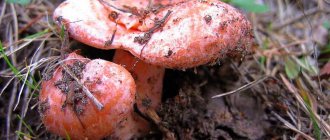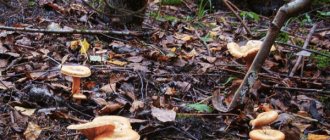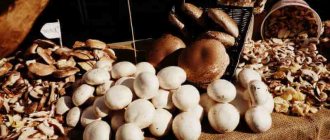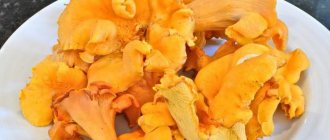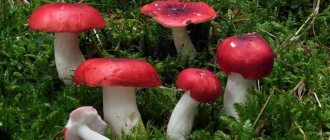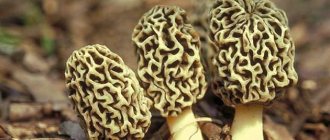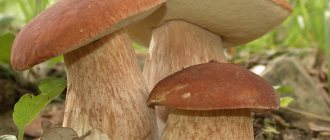Encyclopedia "Mushroom-Info" Mushroom Picker's Guide Why chanterelles are bitter and how to get rid of this problem
Recognizable by their bright appearance, chanterelles are excellent mushrooms due to their taste. These fruiting bodies can be subjected to any processing: frying, boiling, salting, freezing, pickling and drying. Although chanterelles and bitterness are inseparable concepts, after heat treatment the pulp of the mushrooms becomes aromatic, tender and amazingly tasty.
Many novice mushroom pickers wonder: why are chanterelles bitter and what to do to remove this bitterness? It must be said that these mushrooms are unique, because they are not eaten by worms and insects, which means they remain intact and not spoiled. The reason for this is precisely the bitterness of the pulp, which has a detrimental effect on all parasites.
It is worth saying that cleaning and any heat treatment of chanterelles should be carried out on the very day the harvest is harvested. Any delay for a long time can lead to the accumulation of harmful toxins in mushrooms, which can harm human health.
In this article, you can get a comprehensive answer to the question of why chanterelle mushrooms are bitter, as well as familiarize yourself with proven methods that help remove this unpleasant feature.
Why do chanterelles taste bitter after freezing and what should you do if the mushrooms are bitter when defrosted?
Why do chanterelles taste bitter after freezing and what can I do to fix it? Indeed, when taking frozen mushrooms out of the freezer in winter, you can sometimes detect a slight bitterness. If you do not immediately pay attention to this, the prepared dish may be spoiled.
So, why do chanterelle mushrooms taste bitter after defrosting, and what rules should you follow to avoid this? To ensure that there is no unpleasant bitter taste after defrosting, the following recommendations are followed before harvesting:
- Mushrooms are cleared of forest debris, soil or sand and immediately cut off rotten areas.
- Wash thoroughly in plenty of water, stirring with hands.
- Pour in cold water and leave for 1.5-2 hours.
- Drain the water, place the mushrooms on a wire rack and leave for 20-30 minutes to drain.
- After this, the chanterelles are distributed into plastic bags or food containers and placed in the freezer.
Insidious doubles
Mother Nature, along with edible mushrooms, scattered their poisonous clones throughout the forest. These are, first of all, false honey mushrooms, boletus mushrooms, chanterelle mushrooms, champignons, boletus mushrooms and even boletus mushrooms, which are surprisingly similar to white mushrooms. Therefore, answer No. 1 to the question why mushrooms are bitter is this: along with the right gifts of the forest, you also picked up their poisonous counterparts. Even one such false honey fungus, squeezed into a basket, can spoil the entire dish with unbearable bile. I'll have to throw it all away, sadly. It is better to check the authenticity of the find on the spot. As a rule, false mushrooms are very beautiful: bright, untouched by worms and snails. In addition, you can touch the cut of the cap with the tip of your tongue. The deadly poisonous satanic mushroom looks like a white mushroom, but its Ukrainian name “gorchak” speaks for itself. In addition, it turns blue and red when cut.
Why are frozen chanterelles bitter and how to remove bitterness from thawed mushrooms?
But sometimes, even despite following the rules, frozen chanterelles taste bitter, why? It would be better to boil the mushrooms after soaking so that the bitterness goes away for sure.
Another factor why frozen chanterelles remain bitter is the time of harvest. During the dry mushroom season, mushrooms always contain bitterness, which is difficult to remove by soaking.
How can you remove the bitterness from frozen chanterelles if they were prepared raw?
- After defrosting, the mushrooms are immersed in boiling water and cooked for 10-15 minutes over low heat.
- You can add 1 tbsp to the water. l. salt and 2-3 pinches of citric acid. Such actions will help remove the bitter taste from the fruiting bodies.
In addition, heat treatment will give you confidence that the product will not deteriorate after accidentally defrosting the freezer. It is worth adding that boiled chanterelles become more compact and take up less space in the freezer than raw ones.
Let's clarify some facts
To avoid mushroom poisoning, you need to know as much as possible about them. Therefore, we will try to clarify some facts about poisonous and edible mushrooms.
It is believed that poisonous mushrooms must be bitter, ugly and have an unpleasant odor. This is wrong. For example, such dangerous mushrooms as panther fly agaric, toadstool or poisonous roseate have neither taste nor particular smell. And false mushrooms cannot be distinguished from real ones by appearance.
Insects and snails also eat poisonous mushrooms; mushroom pickers often find pale toadstools on which snails sit.
You can be poisoned not only by poisonous mushrooms, but also by edible ones, if they are already old, spoiled and poorly processed.
When poisoning with mushrooms, the following symptoms appear: nausea, abdominal pain, diarrhea, vomiting, weakness, and agitation. If they appear, you need to call an ambulance, but in the meantime, do a gastric lavage with water and potassium permanganate and a cleansing enema. Drink salted water.
In SIBERIA, the bitterness from mushrooms is simply and permanently removed. As a rule, when we prepare milk mushrooms for the winter. We take it and very, very carefully clean the caps and cut off the stems leaving one cm and soak them for three days and change the water twice a day. After three days, wash and salt, add garlic and press under pressure. After 43 days, the crispy delicacy is ready. TO YOUR HEALTH! There is no bitterness and it tastes ten times better than boiled ones, especially with sour cream. It’s the same with other mushrooms, saffron milk caps, tremors, and all types of milk mushrooms.
Many mushrooms contain bitterness and care must be taken to remove this bitterness before cooking them. Basically, you need to remove bitterness from: chanterelles, milk mushrooms, white mushrooms, undertoppolniks, volnushki, and there may also be bitterness in mushrooms such as valui.
The main and universal way to remove bitterness from mushrooms is to first clean them of dirt and leaves and then soak them in cold water. Let’s say that in order to remove the bitterness from milk mushrooms in this way, you need to keep them in water for two or three days. In this case, you need to change the water every day.
You can also add a little salt to the water, this will improve the process of drawing out the bitterness from them. The container with water and milk mushrooms should be kept in a cool place these days. Otherwise, the mushrooms may spoil.
Well, the fastest way to get rid of the bitterness of mushrooms is, of course, boiling. From any mushrooms, for example, before frying, you can remove all poisons and harmful substances by boiling them in salted water for 15-20 minutes. You can boil it twice. Boil for 15 minutes, drain the water, and return to boil for 15 minutes. But usually once is enough.
How else can you remove the bitterness from chanterelles after freezing?
How to remove bitterness from chanterelles after freezing in another interesting way? Frozen fresh mushrooms are delicious when made into soup or added to fried potatoes. But there are problematic situations when mushrooms taste bitter. Therefore, after freezing, the fruiting bodies are first defrosted. Next, the question arises: how to remove the bitterness from thawed chanterelles so that the dish prepared from them does not lose its mushroom taste and aroma? In this case, the mushrooms are blanched in boiling salted water for 5-7 minutes, having previously placed them in a colander after defrosting.
I would like to draw your attention to the fact that it is best to freeze only young specimens of chanterelles that have not fully straightened their caps. Such fruiting bodies have practically no bitter taste and contain more nutrients and vitamins in their composition than overripe ones.
Many experienced housewives prefer to freeze chanterelles directly in the mushroom broth in which they were cooked. Note that this method is convenient, because in the future the mushrooms are used immediately after removal from the freezer without prior defrosting. The prepared first courses from this preparation turn out incredibly tasty.
However, it happens that even in broth, mushrooms have a slightly bitter taste. Why do chanterelles taste bitter after cooking and how can I correct the situation?
- The preparation for the first courses is thawed, the broth is drained, and the mushrooms are washed under a tap with cold water.
- Pour in a small amount of water, adding one onion, cut into 4 parts, and boil for 10 minutes over medium heat.
- Place in a colander, allow to drain and begin further processing processes.
Collecting the right mushrooms
Many edible and conditionally edible mushrooms have poisonous analogues, or false mushrooms - false honey mushrooms, false chanterelles, boletus, champignons, and even false porcini mushrooms, considered royal.
It will not be possible to remove the bitterness from them even after long-term processing; moreover, in addition to the bitterness, they will also contain poisons that are dangerous to humans, so you need to collect only those mushrooms whose quality is beyond doubt.
For example, gall mushroom, or bitterling, is not edible, although in appearance it can easily be mistaken for boletus, boletus or porcini mushroom. Cooking bitters only enhances the bitterness.
Experienced mushroom pickers warn that even one poisonous and bitter mushroom can ruin the entire dish; its bitterness is enough for everyone. Therefore, it is better to check mushrooms in the forest. Poisonous analogues of edible mushrooms look brighter and more beautiful than non-poisonous ones. They are rarely eaten by worms, snails and insects, but that's not all - when cut, the poisonous mushroom turns blue, while its edible counterpart turns red.
Bitterness is noted in milk mushrooms - milk mushrooms, travelers, chanterelles, volnushki, podtopolniks, white mushrooms, valuevs and some other edible mushrooms.
Mushrooms collected in coniferous forests are more bitter than mushrooms from deciduous forests, even if they belong to the same species and family. In addition, “coniferous” mushrooms have a resinous aftertaste that is not so easy to remove.
Another reason for bitterness in edible mushrooms is lack of moisture. Immediately after rain, mushrooms are tasty, but after a week, due to the heat, their taste can change greatly for the worse. Due to lack of moisture, they become bitter or bilious.
Mushrooms will be bitter in polluted areas; everyone knows that they, like a sponge, absorb everything that is in the air, soil and water. You cannot even collect edible mushrooms growing along roads, near large industrial enterprises, landfills and other pollutants. You only need to cut mushrooms with a stainless steel knife or a ceramic knife.
Some mushrooms are naturally bitter!
How to get rid of bitterness in chanterelles after boiling?
After preliminary boiling, the chanterelles remain bitter, what should you do in this case? There may be several reasons for this: for example, the individual characteristics of the fruiting bodies, the presence of toxins in the pulp, as well as improper processing.
The natural bitter taste of chanterelles can complicate the technology and increase the cooking time. But thanks to this bitterness, the appearance of the fruiting bodies is practically not spoiled by insect pests that do not like bitter food.
It is worth saying that although the bitterness of mushrooms does not harm human health, many people do not like this taste. Therefore, in order to get rid of the bitter taste of chanterelles when boiling, salt, citric acid, bay leaves, clove buds and allspice are added to the water. After the first cooking for 5-8 minutes, drain the water and add new water. Boil again, but without adding salt and spices.
In addition, there is a method that simplifies the task and shows how to get rid of bitterness in chanterelles. After boiling in salted water for 15 minutes, the mushrooms can be prepared marinated or added to the dish with various sauces and toppings. This method will make the bitter taste of chanterelles less noticeable. As a rule, you can get used to the specific taste of fruiting bodies if you constantly consume them. But those who rarely eat chanterelles immediately notice the bitterness.
However, do not forget about an important factor that will help avoid bitterness: collect small mushrooms with unopened caps!
Incorrect processing
Another reason why fried mushrooms are bitter is their incorrect culinary preparation. There are species that are edible and even very tasty and healthy - such as milk mushrooms. But under no circumstances should you simply peel them and crumble them into a frying pan. Such mushrooms are first soaked and the water is drained. Then they boil it (some cooks even several times). In addition to milk mushrooms, russula and some chanterelles also taste bitter in a frying pan. All mushrooms collected in coniferous forests acquire a resinous taste in their fruiting bodies, which not everyone likes.
Why are fried chanterelles bitter and what can I do to get rid of the problem?
It often happens that even after frying, chanterelles taste bitter, why does this happen? When a housewife encounters such problems for the first time, it leads her to bewilderment and doubts creep in about the edibility of mushrooms.
Why fried chanterelles taste bitter is a very practical question. Perhaps the fact is that the mushrooms contained false chanterelles, which have a strong bitterness in the pulp, which spoiled the taste of all the mushrooms. Therefore, if there is even a drop of doubt about what mushrooms you have collected and prepared, it is better not to be tempted and throw them away.
Another option why chanterelles become bitter when fried is the lack of pre-soaking of the mushrooms. This should be done immediately after cleaning: pour cold water over the mushroom harvest and leave for 1.5-2 hours. Then rinse in plenty of water, and then proceed to further processing.
Some chefs have noticed why chanterelles remain bitter after frying. The peculiarity of this problem is that, after being brought home, the mushrooms could have been unprocessed for a long time, accumulating toxic substances in the pulp.
Before frying, the mushrooms are soaked, boiled in boiling salted water and only then fried. Although such processes require additional time, the bitterness inherent in chanterelles will definitely go away.
Why are chanterelles bitter after frying and can this be fixed?
What should you do if fried chanterelles taste bitter even after pre-soaking and boiling? Perhaps the fruiting bodies were burnt or were fried in bitter sunflower oil. Then with such chanterelles you need to do the following: add sour cream or mayonnaise, spices and simmer over low heat for 15 minutes. You can try to correct the situation as follows: roll boiled mushrooms in flour and cook in butter with the addition of onions fried in sugar.
The reasons why bitterness remains after frying may be completely different. When boiling, try putting a thick cloth bag with spices in the water: cloves, bay leaves, cinnamon sticks, fresh dill and parsley. If you have tried all the manipulations to remove the bitterness, but it still remains, throw away the mushrooms without regretting the time spent and your efforts.
Ecology
In the question “why are mushrooms bitter”, one cannot discount the conditions in which the fruiting bodies grew. Their spongy structure absorbs everything that is carried in the air, spilled in groundwater or lying in the ground. Champignons found in city public gardens have been sprinkled not only by summer rain, but also by numerous dogs, so their taste is distinctly urine. Mushrooms near roadsides are not only not tasty, but also dangerous to health. Even boletus contains heavy metals and poisons from exhaust gases.
